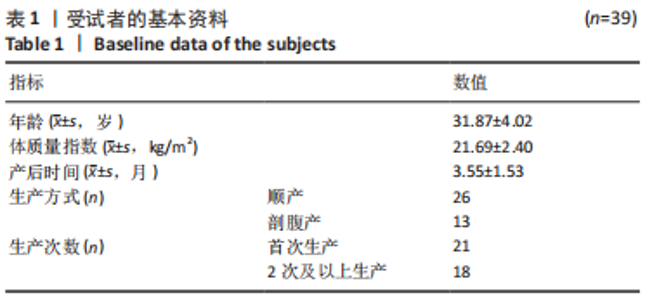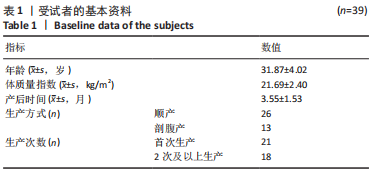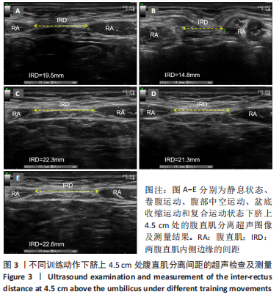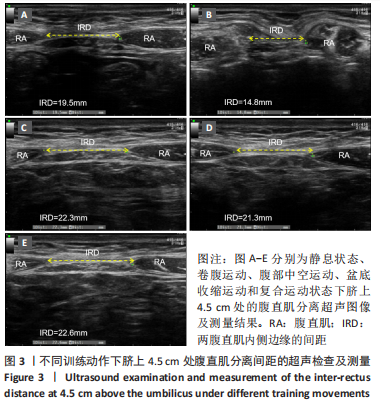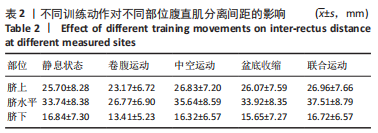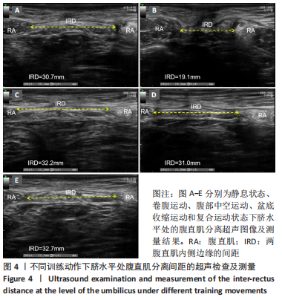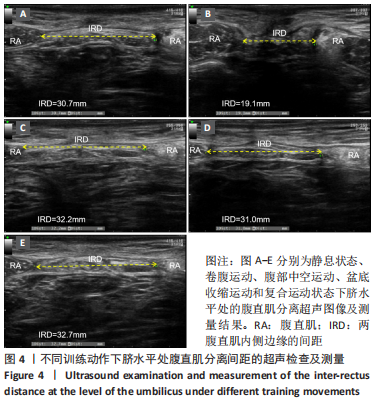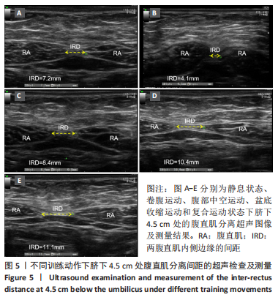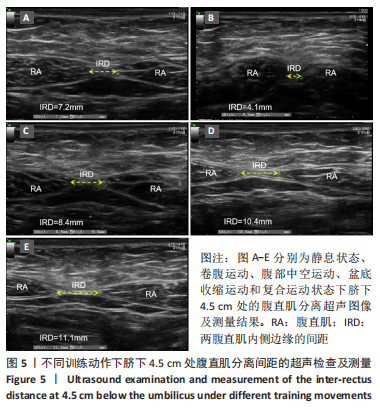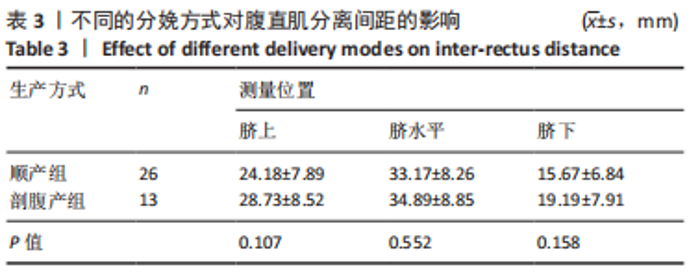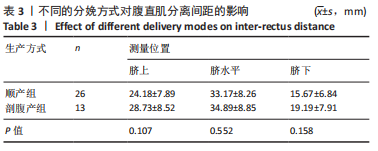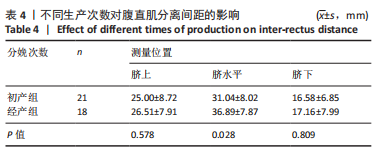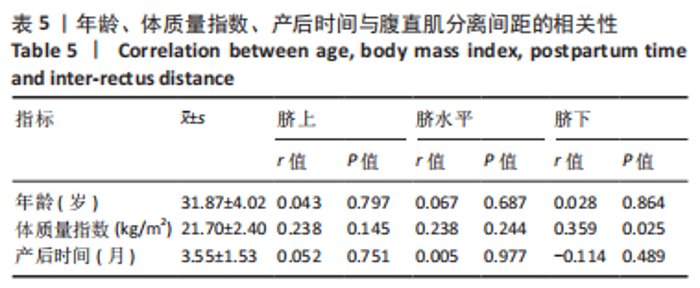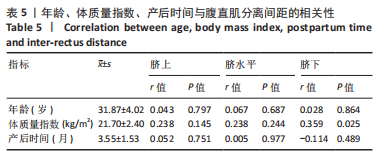[1] NAHABEDIAN MY, NAHABEDIAN AG. Closing the gap for patients with rectus abdominis diastasis. Nursing. 2018;48(1):49-52.
[2] 朱望爱, 王乐丹, 胡越. 腹直肌分离研究进展[J]. 浙江医学,2020,42(5): 525-528.
[3] DA MOTA P GF, PASCOAL AG BA, CARITA AI AD, et al. Prevalence and risk factors of diastasis recti abdominis from late pregnancy to 6 months postpartum, and relationship with lumbo-pelvic pain. Manual Ther. 2015;20(1):200-205.
[4] SPERSTAD JB, TENNFJORD MK, HILDE G, et al. Diastasis recti abdominis during pregnancy and 12 months after childbirth: prevalence, risk factors and report of lumbopelvic pain. Brit J Sport Med. 2016;50(17):1092-1096.
[5] BENJAMIN DR, FRAWLEY HC, SHIELDS N, et al. Relationship between diastasis of the rectus abdominis muscle (DRAM) and musculoskeletal dysfunctions, pain and quality of life: a systematic review. Physiotherapy. 2019;105(1):24-34.
[6] HA W, SONG SY, YOON CS, et al. Severe irreversible diastasis recti abdominis and abdominal hernia in postpartum women: rare case report. Int Surg. 2021; 105(1-3):10-13.
[7] KEELER J, ALBRECHT M, EBERHARDT L, et al. Diastasis recti abdominis: a survey of women’s health specialists for current physical therapy clinical practice for postpartum women. J Womens Health. 2012;36(3):131-142.
[8] MOTA P, PASCOAL AG, SANCHO F, et al. Test-retest and intrarater reliability of 2-dimensional ultrasound measurements of distance between rectus abdominis in women. J Orthop Sport Phys. 2012;42(11):940-946.
[9] MOTA P, PASCOAL AG, CARITA AI, et al. The immediate effects on inter-rectus distance of abdominal crunch and drawing-in exercises during pregnancy and the postpartum period. J Orthop Sport Phys. 2015;45(10):781-788.
[10] PASCOAL AG, DIONISIO S, CORDEIRO F, et al. Inter-rectus distance in postpartum women can be reduced by isometric contraction of the abdominal muscles: a preliminary case–control study. Physiotherapy. 2014; 100(4):344-348.
[11] THEODORSEN NM, STRAND LI, BØ K. Effect of pelvic floor and transversus abdominis muscle contraction on inter-rectus distance in postpartum women: a cross-sectional experimental study. Physiotherapy. 2019;105(3):315-320.
[12] PEREIRA LC, BOTELHO S, MARQUES J, et al. Are transversus abdominis/oblique internal and pelvic floor muscles coactivated during pregnancy and postpartum? Neurourol Urodynam. 2013;32(5):416-419.
[13] BEAMISH N, GREEN N, NIEUWOLD E, et al. Differences in linea alba stiffness and linea alba distortion between women with and without diastasis recti abdominis: the impact of measurement site and task. J Orthop Sport Phys. 2019;49(9):656-665.
[14] VAN DE WATER ATM, BENJAMIN DR. Measurement methods to assess diastasis of the rectus abdominis muscle (DRAM): a systematic review of their measurement properties and meta-analytic reliability generalisation. Manual Ther. 2016;21:41-53.
[15] LEE D, HODGES PW. Behavior of the linea alba during a curl-up task in diastasis rectus abdominis: an observational study. J Orthop Sport Phys. 2016;46(7):580-589.
[16] BENJAMIN DR, VAN DE WATER ATM, PEIRIS CL. Effects of exercise on diastasis of the rectus abdominis muscle in the antenatal and postnatal periods: a systematic review. Physiotherapy. 2014;100(1):1-8.
[17] 胡秀红, 李景珊, 李旺英. 产后早期女性腹直肌分离的多位点高频超声特征与不同分娩方式的相关性分析[J]. 实用医技杂志,2021,28(11):1310-1312.
[18] 刘雅莉, 赵琼蕊, 李娟, 等. 中国育龄期妇女产后腹直肌分离发生率 meta 分析[J]. 中国公共卫生,2020,36(10):1507-1509.
[19] 张红芸, 李小永, 鲁红. 产后腹直肌分离高频超声特征及其与分娩方式的关系[J]. 中华超声影像学杂志,2020,29(11):982-986.
[20] 焦子珊, 邱金花, 王娜娜, 等. 489 例产后腹直肌分离产妇患病现状及影响因素分析[J]. 护理学报,2021,28(20):7-10.
[21] 李玲,崔金晖,欧阳丽萍,等.产后腹直肌分离的相关危险因素分析[J].中山大学学报(医学科学版),2021,42(5):790-795.
[22] 孙秀丽, 李环, 苏园园, 等. 产后腹直肌分离诊断与治疗的专家共识[J]. 中国妇产科临床杂志,2021,22(2):220-221.
[23] ORMSBEE MJ, PRADO CM, ILICH JZ, et al. Osteosarcopenic obesity: the role of bone, muscle, and fat on health. J Cachexia Sarcopeni. 2014;5(3):183-192.
[24] CHOI ES, CHO SH, KIM JH. Relationship between rectus abdominis muscle thickness and metabolic syndrome in middle-aged men. PloS One. 2017; 12(9):e0185040.
[25] FEI H, LIU Y, LI M, et al. The relationship of severity in diastasis recti abdominis and pelvic floor dysfunction: a retrospective cohort study. BMC Women’s Health. 2021;21(1):1-8.
[26] GLUPPE SB, ENGH ME, BØ K. Immediate effect of abdominal and pelvic floor muscle exercises on interrecti distance in women with diastasis recti abdominis who were parous. Phys Ther. 2020;100(8):1372-1383.
[27] LEE DG, LEE LJ, MCLAUGHLIN L. Stability, continence and breathing: the role of fascia following pregnancy and delivery. J Bodyw Mov Ther. 2008;12(4):333-348.
[28] SANCHO MF, PASCOAL AG, MOTA P, et al. Abdominal exercises affect inter-rectus distance in postpartum women: a two-dimensional ultrasound study. Physiotherapy. 2015;101(3):286-291.
[29] BALASCH-BERNAT M, PÉREZ-ALENDA S, CARRASCO JJ, et al. Differences in Inter-Rectus Distance and Abdominopelvic Function between Nulliparous, Primiparous and Multiparous Women. Int J Environ Res Public Health. 2021;18(23):12396.
[30] MOTA P, PASCOAL AG, CARITA AI, et al. Normal width of the inter-recti distance in pregnant and postpartum primiparous women. Musculoskelet Sci Pract. 2018;35:34-37.
[31] KESHWANI N, MATHUR S, MCLEAN L. Validity of Inter-rectus Distance Measurement in Postpartum Women Using Extended Field-of-View Ultrasound Imaging Techniques. J Orthop Sports Phys Ther. 2015;45(10):808-813.
[32] EISENBERG VH, SELA L, WEISMAN A, et al. The relationship between diastasis rectus abdominus, pelvic floor trauma and function in primiparous women postpartum. Int Urogynecol J. 2021;32(9):2367-2375.
[33] HE K, ZHOU X, ZHU Y, et al. Muscle elasticity is different in individuals with diastasis recti abdominis than healthy volunteers. Insights Imaging. 2021;12(1):87.
[34] THABET AA, ALSHEHRI MA. Efficacy of deep core stability exercise program in postpartum women with diastasis recti abdominis: a randomised controlled trial. J Musculoskelet Neuronal Interact. 2019;19(1):62-68.
[35] GLUPPE S, ENGH ME, BØ K. What is the evidence for abdominal and pelvic floor muscle training to treat diastasis recti abdominis postpartum? A systematic review with meta-analysis. Braz J Phys Ther. 2021;25(6):664-675.
[36] GLUPPE SL, HILDE G, TENNFJORD MK, et al. Effect of a Postpartum Training Program on the Prevalence of Diastasis Recti Abdominis in Postpartum Primiparous Women: A Randomized Controlled Trial. Phys Ther. 2018;98(4):260-268.
|
